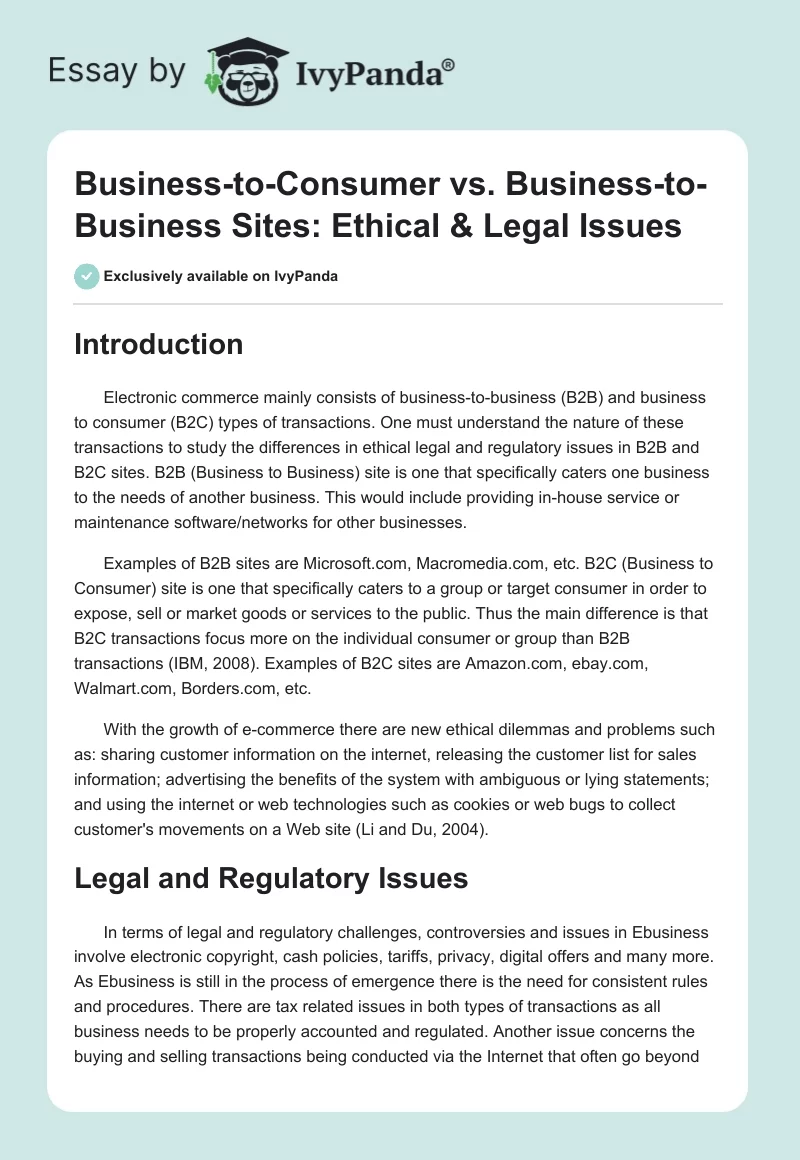Introduction
Electronic commerce mainly consists of business-to-business (B2B) and business to consumer (B2C) types of transactions. One must understand the nature of these transactions to study the differences in ethical legal and regulatory issues in B2B and B2C sites. B2B (Business to Business) site is one that specifically caters one business to the needs of another business. This would include providing in-house service or maintenance software/networks for other businesses.
Examples of B2B sites are Microsoft.com, Macromedia.com, etc. B2C (Business to Consumer) site is one that specifically caters to a group or target consumer in order to expose, sell or market goods or services to the public. Thus the main difference is that B2C transactions focus more on the individual consumer or group than B2B transactions (IBM, 2008). Examples of B2C sites are Amazon.com, ebay.com, Walmart.com, Borders.com, etc.
With the growth of e-commerce there are new ethical dilemmas and problems such as: sharing customer information on the internet, releasing the customer list for sales information; advertising the benefits of the system with ambiguous or lying statements; and using the internet or web technologies such as cookies or web bugs to collect customer’s movements on a Web site (Li and Du, 2004).
Legal and Regulatory Issues
In terms of legal and regulatory challenges, controversies and issues in Ebusiness involve electronic copyright, cash policies, tariffs, privacy, digital offers and many more. As Ebusiness is still in the process of emergence there is the need for consistent rules and procedures. There are tax related issues in both types of transactions as all business needs to be properly accounted and regulated. Another issue concerns the buying and selling transactions being conducted via the Internet that often go beyond the national boundaries of one country. This emphasizes the role of Government and laws of other nations (Walsh, K. 2001). However, both of these issues affect B2C transactions more as it involves buying and selling goods or services, sometimes across borders.
B2B online transactions are largely managed through private contracts. Contracts act as legal statutes binding the players together, defining roles and responsibilities and providing for ready made dispute resolution method (Bidgoli, 2004). On the other hand, B2C online transactions are regulated by terms of sale, contracts and consumer law more generally. Disputes from B2B sites are mostly resolved through legal proceedings citing terms in the contract.
These proceedings could either be online dispute resolution methods using a cybercourt or normal legal proceedings in a court of law. Most disputes from B2C transactions are settled relatively painlessly under terms of sale or in some rare cases settled via consumer protection law or other legal mechanism. Cross border transactions are regulated through transnational agreements such as the General Agreement on Tariffs and Trade (GATT) (Bidgoli, 2004) in the case of B2C.
On the B2C market, consumer protection is very important. Legislation usually emphasizes the consumer’s protection, especially when food is sold. On B2B markets legislation generally treats both sides of the contracts equally (Barschel, 2007).
There are also differences in the context of problem on duties regarding warranty. Less reliability is placed on the statements of the seller in B2B activities than in B2C transactions. The assumption here is that with business as the client there is an expectation of a greater level of expertise than the consumer.
But as a whole, the World Wide Web is unregulated. Although there are regulatory rules and regulations in form of laws and acts like CAN-SPAM, gambling laws, Federal Telecommunications Act and the Computer Decency Act among others, still the Internet has been in a large part open to the free operation of the market.
Ethical Issues
Ethical perspective requires that all participants in a business transaction act with moral responsibility. When it comes to ethical issues the main difference can be seen on the level of attention given by the people to the two types of transactions: B2B and B2C. As the principal ethical contention in Ebusiness is trust, the focus on this value tends to give more weight on the B2C and the risk that it poses to traditional ways of doing business.
So far critics like the writers have largely given least weight on the ethical issues that are instigated by enormous potential of the Internet in the B2B transactions. Ethical issues on ebusiness tend to give emphasis on activities or transactions that are connected or related with the sensitivity of collected information that is in turn held and transferred by means of Internet mediated communication. Ethical issues include the matter of privacy regarding individuals’ information, the veracity of the given information, ownership of the information or intellectual property rights and the accessibility of the computer held information. These just manifest that emphasis is very much directed towards the individual consumer. These also imply a disregard on the valuable area of electronic commerce or the business-to-business.
In the B2B information control issues that are based on case privacy are less critical when it comes to the personal level. However, moral precepts are also relevant to the business to business. From time to time there are instances of ethical dilemmas in B2B sites as well. These cases may be related to: freedom of choice; transparency; facilitating fraud (ethical/illegal activities of others). (Harris, L. 2002).
Works Cited
Barschel, Hauke (2007). B2B versus B2C Marketing – Major Differences along the Supply Chain of Fast Moving Consumer Goods (FMCG). GRIN Verlag Publishers.
Bidgoli, Hossein (2004). The Internet Encyclopedia. John Wiley and Sons.
Harris, L. (2002). The Ethics of E-Banking. Journal of Electronic Commerce Research, VOL. 3, Issue 2.
IBM (2008). How B2B differs from B2C. iSeries Information Center. Web.
Li, Eldon and Du, C. Timon (2004). Advances in Electronic Business. Idea Group Inc (IGI).


